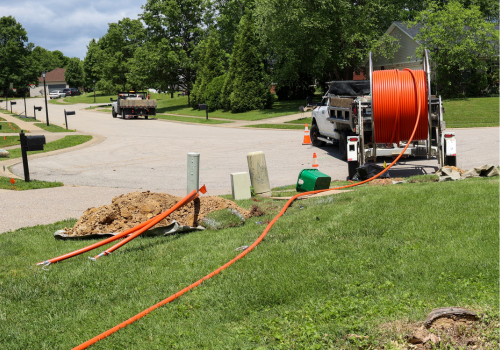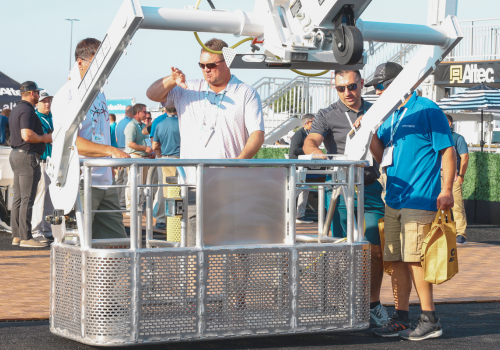 Consider emissions, maintenance, comfort and cost
Consider emissions, maintenance, comfort and cost
As consumers begin to embrace electric vehicle (EV) options, industry analyst BlastPoint projects a 70 percent increase in EV sales 2021 – despite pandemic-led downturns in car travel. Although still a small percentage of the total automotive market, EVs appear to be coming into their own.
While electric power may be fine for passenger cars, what about commercial construction equipment subjected to the daily grind of utility work? Are electric backhoes and excavators up to the task?
Electric compact construction equipment offers multiple benefits and options for utilities, utility contractors and municipalities.
Top-of-mind among electrification benefits are zero engine emissions and low engine noise – important considerations for contractors operating at public job sites.
With quiet operation and no fumes, compact electric equipment can operate virtually anywhere, says Bart DeHaven, national sales manager at KATO-CES, which offers four electric mini excavator models.
“In most cities and states, you can’t run a diesel engine indoors. We’re seeing a lot of plumbing and utility contractors going into old malls or big box stores to split them up into smaller businesses,” DeHaven says. “Small electric excavators can easily dig trenches for plumbing or electrical systems within these enclosed spaces.”
 Worker safety and comfort
Worker safety and comfort
Competition for skilled workers continues to be an issue for the utility industry. Electric power contributes to a safer, more comfortable workplace that may be more attractive to recruits. Diesel engine emissions can cause asthma and other lung diseases. With zero emissions, electric compact equipment reduces worker health risks.
Lower engine noise is another factor.
“Noise is tiresome for the operator,” points out Lars Arnold, product manager at Volvo Construction Equipment, which will demonstrate their new electric loader and mini excavator at this year’s Utility Expo. Although no data is available to document fatigue levels, workers testing new Volvo electric models report being less tired after finishing a work shift due to the quieter operation, Arnold says.
Also, with lower engine noise, workers can more easily hear each other for better job site communication.
 Operational performance
Operational performance
Quieter operation does not mean lower performance. Compact electric construction equipment manufacturers report no differences in power, breakout force nor lift capacity with electric versus diesel.
Cold weather does not hamper electric engine starting, although DeHaven says the battery charge may not last as long at low temperatures. Volvo tested its electric machines under both hot and cold conditions and found no differences in performance when operating between 14 and 104 degrees F (-10 and 40 degrees C), according to Arnold.
Electric machines may have advantages over diesel in torque response.
“At low idle a diesel engine has reduced torque and requires time for the engine to ramp up to meet the load demands. Electric motors, on the other hand, have instantaneous torque and peak torque is available at every operating speed,” says Ed Brenton, product manager, CASE Construction Equipment.
Battery charging takes from four to eight hours, with fast-charging systems achieving the lower end of the charging range. One charge will last through a full eight-hour work shift or longer.
For most applications, contractors drive or trailer machines back to a shop or yard for charging at the end of the day. Utility companies with electric equipment fleets can use their own electricity for charging, essentially operating the machines at cost.
However, remote job sites without electric service can be problematic.
“A good solution would be a solar array to collect electricity during the day and charge machines at night,” says Arnold. Other options are large mobile power banks or on-site generators.
Cost considerations
Initial purchase price may give pause to those considering electric compact equipment. Manufacturer representatives say electric machine prices can range 45 to 100 percent higher than comparable models equipped with diesel engines. However, cost of operation over the machine’s lifetime may equalize the economics. For example:
- No engine maintenance. Diesel engines require oil and air filter changes, often as frequently as every 100 hours of operation. Electric machines are virtually maintenance-free, requiring only occasional greasing and hydraulic system servicing. “Maintenance costs are often overlooked. For electric machines this represents a huge savings each year,” notes DeHaven.
CASE Construction Equipment estimates its electric backhoe loader will save as much as 90 percent in annual machine and maintenance costs, including diesel fuel savings. For those interested in determining their own potential savings, Volvo plans to offer a cost calculator at its Utility Expo display this year.
- Reduced engine hours. Unlike diesel engines that remain at idle speed during downtime, electric machines offer instant power on-power off. That means the electric machine accumulates fewer operating hours – a factor in resale value, according to Arnold. “A diesel machine may spend 30 to 40 percent of an eight-hour shift idling and collecting time on the operating meter,” he says. During idling, the diesel machine also consumes fuel – not a concern with a powered-down electric machine.
- Machine longevity. With proper charging and care, electric engines and batteries can be expected to last as long as comparable diesel machines, manufacturers say. Expect new electric purchases to come with warranties, often for several years.
 What drives electric adoption?
What drives electric adoption?
Early adopters of electric technology are customers with business reasons to reduce emissions and noise. Utilities and municipal public works departments often have sustainability goals and initiatives in place that favor electrification. Contractors bidding work in states with certain regulations – such as New York, California and Florida – may also benefit from operating electric machines.
New York State Gas & Electric (NYSGE) and Rochester Gas & Electric (RG&E) purchased the first CASE electric backhoes earlier this year. These machines help the utilities’ meet sustainability goals, provide cleaner work environments and be more responsible neighbors, according to NYSGE and RG&E President and CEO Carl Taylor.
“As an energy provider, we have a responsibility to be good stewards of the environment and build a more sustainable future for our communities,” Taylor says.
Future outlook
Arnold envisions a day when electricity will take over liquid fuels in the compact construction equipment marketplace.
“I believe there will be slow growth in the beginning and at a certain tipping point, growth will be exponential,” says Arnold. Tipping point factors include regulatory considerations, potential subsidies for purchase, and the willingness of customers to achieve zero emissions.
DeHaven believes future electric equipment use hinges on consumers and cost.
“Electric won’t completely take over the market. How fast the market grows depends on cost effectiveness, what the public wants and the desire for green operations,” he says.
Brands featured in this article:
Join thousands of industry peers who receive utility construction industry news and trends each week. Subscribe to The Utility Expo Newsletter.












